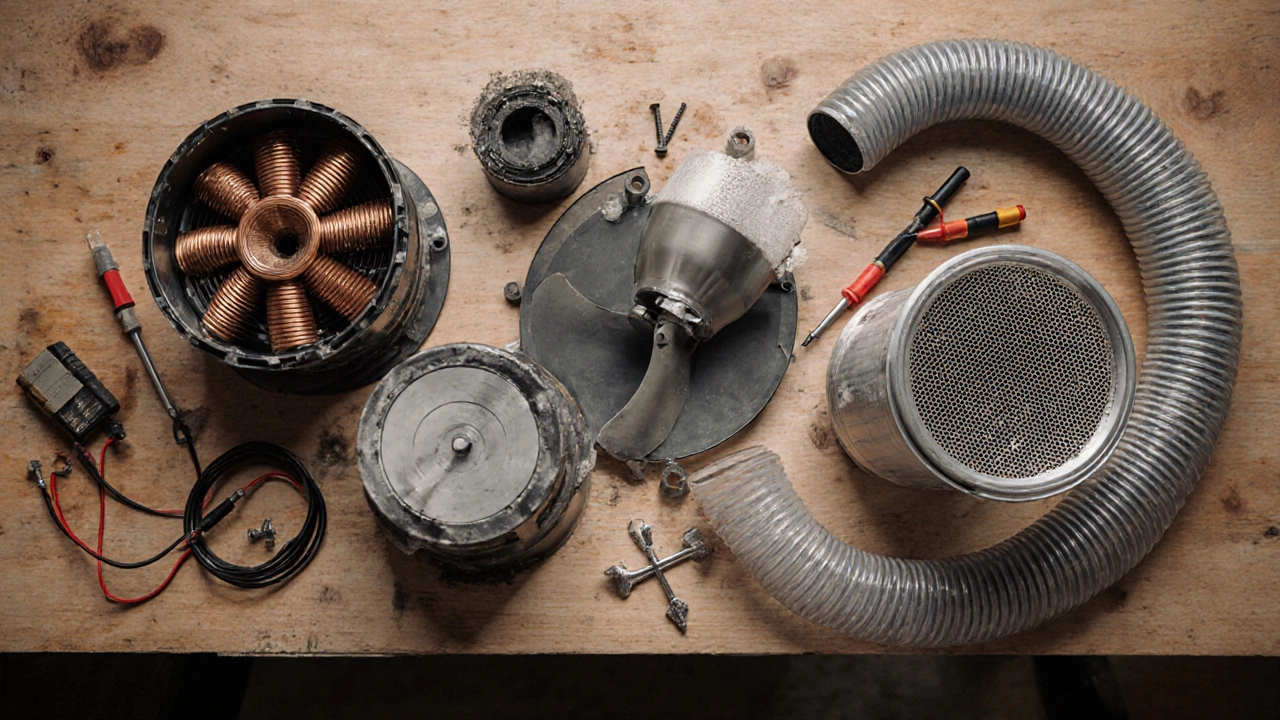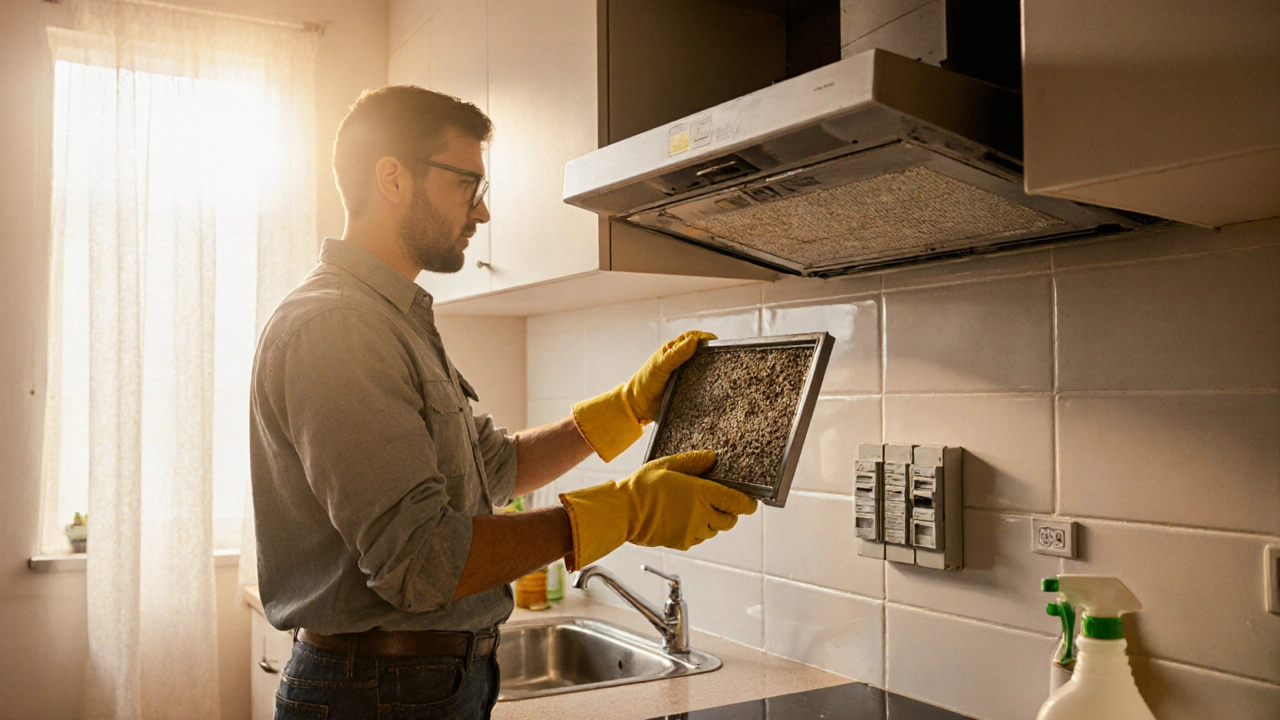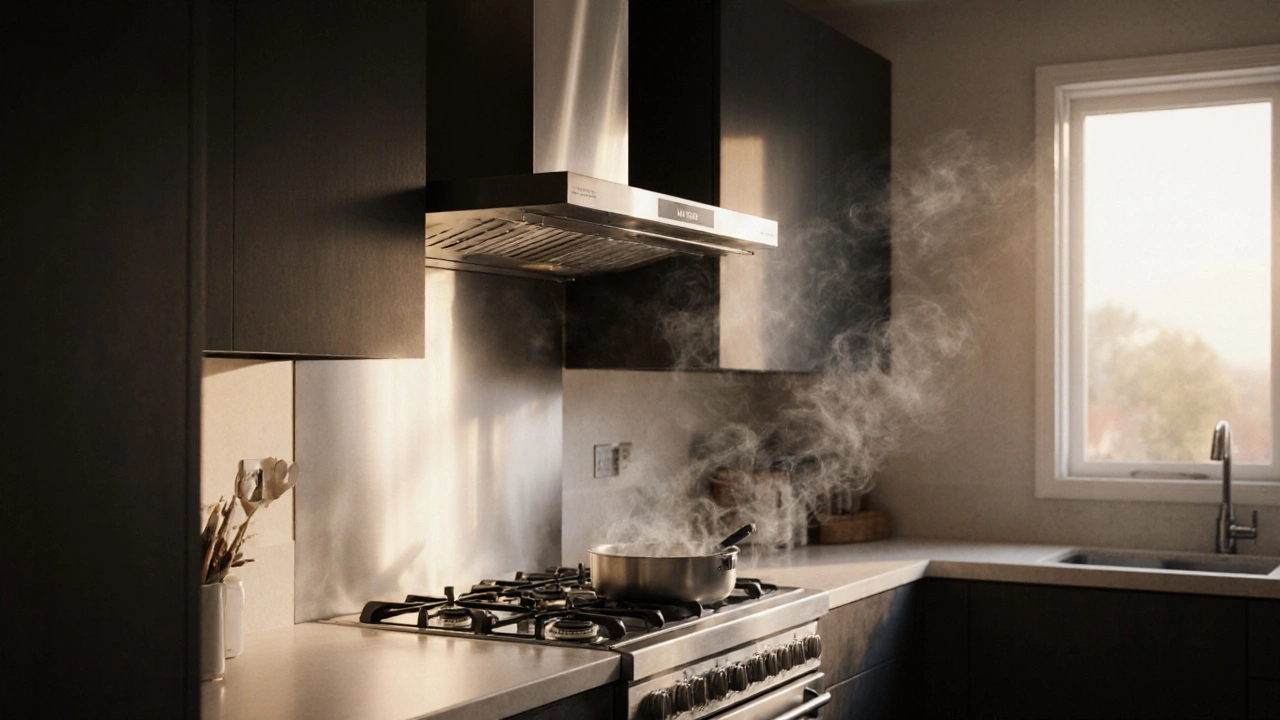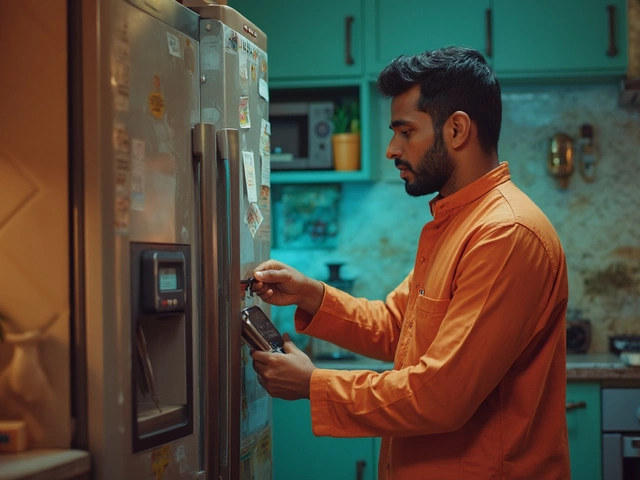Kitchen Fan Failure Diagnostic Tool
Select all symptoms you're experiencing with your kitchen extractor fan:
Potential Causes Identified
Recommended Actions
Ever wonder why that humming fan you rely on to keep your kitchen smoke‑free just goes silent? The kitchen extractor fan not working can turn cooking into a sweaty, smelly chore, and the cause is rarely a mystery once you know what to look for.
How a kitchen extractor fan actually works
Understanding the basics makes troubleshooting less guess‑work. A typical kitchen extractor fan is a ventilation unit that pulls air, moisture, and odors out of the cooking area and vents them outside or through a filter. Inside, the key players are:
- Motor - the heart that spins the fan blades.
- Fan blade - attached to the motor, it creates the airflow.
- Capacitor - gives the motor the extra push it needs to start.
- Filter - traps grease and smoke if the unit is recirculating.
- Wiring - carries electricity from the house to the fan.
- Circuit breaker - protects the fan from overload.
- Thermostat / overheat sensor - shuts the fan off if it gets too hot.
- Vent hose or duct - channels the expelled air outside.
When any of these parts fail or are blocked, the fan either runs slower, makes strange noises, or stops entirely.
Top reasons kitchen extractor fans stop working
- Motor burnout - Over time, the motor’s bearings wear out or the windings overheat, especially in units that run for long periods. A burnt‑out motor will click or make a faint hum before going silent.
- Failed capacitor - The capacitor stores a quick burst of energy to get the motor turning. If it dries out (common in humid kitchens), the motor may spin slowly or not start at all.
- Clogged filter or vent hose - Grease builds up on metal or charcoal filters, and dust can block the duct. Restricted airflow forces the motor to work harder, leading to premature failure.
- Loose or damaged wiring - Heat, moisture, or rodents can chew wires. A loose connection often causes intermittent power loss.
- Tripped circuit breaker or blown fuse - A short circuit or overload will shut off power to the fan. Resetting the breaker may restore function, but the underlying issue needs fixing.
- Faulty thermostat / overheat sensor - Designed to protect the motor, a stuck sensor can shut the fan off even when temperatures are normal.
- Switch or control board failure - The wall switch, pull‑chain, or electronic control unit can wear out, preventing the fan from receiving the start signal.
- Excessive vibration - Unbalanced blades or a misaligned duct can cause the unit to shake, eventually loosening screws and damaging internal components.

Step‑by‑step diagnostic checklist
- Confirm power - flip the kitchen light switch that shares the same circuit, or plug a lamp into the fan’s outlet.
- Inspect the circuit breaker - look for a tripped lever and reset it if needed.
- Listen for motor noise - a faint hum means the motor is getting power but can't start, pointing to capacitor or motor issues.
- Check the filter - remove and clean or replace it. If the fan runs after cleaning, the problem was airflow restriction.
- Examine the vent hose - detach it (if accessible) and blow air through. Any resistance suggests a blockage.
- Look at wiring connections - turn off the main power, unscrew the fan’s cover, and verify that all wires are tight and undamaged.
- Test the capacitor - use a multimeter set to capacitance. A reading far below the printed value means replacement.
- Swap the switch - if you have a spare wall switch, connect it temporarily to see if the fan powers on.
If any step points to a component that’s clearly damaged, it’s time for a repair or replacement.
DIY fixes vs. when to call a professional
Most homeowners can handle the low‑risk items themselves. Here’s a quick guide:
- Filter cleaning/replacement - Safe for anyone. Use hot, soapy water for metal filters; replace charcoal filters every 6‑12 months.
- Vent hose clearing - Detach the duct, vacuum out debris, and re‑attach with a screwdriver.
- Capacitor swap - Requires basic electrical safety (turn off power, discharge the capacitor). If you’re comfortable with a multimeter, swap it for a new one of the same microfarad rating.
- Motor replacement - Involves disconnecting wiring and possibly removing the fan housing. If you’re not experienced with appliance disassembly, a qualified technician will save you time.
- Wiring repair - Any signs of burnt insulation, exposed copper, or rodent damage call an electrician. Improper repairs can create fire hazards.
When in doubt, especially with motor or control‑board issues, professional help ensures the fan is re‑wired safely and meets local building codes.

Maintenance habits that keep your fan humming
- Clean the filter every 4‑6 weeks if you cook often; a quick wipe after each heavy‑smoke session helps.
- Run the fan for at least 5 minutes after cooking to dry out moisture that can corrode components.
- Inspect the vent hood for grease splatter; a light spray of kitchen‑safe degreaser prevents buildup on the housing.
- Schedule a professional check‑up once a year - they can lubricate the motor bearings and test the capacitor.
- Keep the area around the fan clear of pots, pans, and clutter to avoid accidental knocks on the switch or blades.
Comparison of common failure types
| Failure | Key Symptom | Likely Cause | Average Repair Cost (CAD) | DIY Feasible? |
|---|---|---|---|---|
| Motor burnout | Silent, occasional click | Overheating, prolonged use | 120‑180 | No (requires replacement) |
| Capacitor failure | Slow spin or no start | Moisture, age | 30‑50 | Yes (basic electrical safety) |
| Clogged filter/duct | Weak airflow, humming | Grease buildup | 0‑20 (clean) / 40‑80 (new filter) | Yes |
| Wiring issue | Intermittent power | Loose connections, rodent damage | 50‑100 | Only if qualified |
| Thermostat sensor | Fan shuts off early | Sensor stuck or failed | 40‑70 | Yes (replace sensor) |
Frequently Asked Questions
Why does my extractor fan make a rattling noise?
Rattling usually means a loose fan blade, a worn motor bearing, or a mis‑aligned vent hose. Turn off power, remove the housing, and tighten any screws you find. If the noise persists, the motor may need replacement.
Can I clean a charcoal filter with water?
No. Charcoal filters absorb odors chemically; washing them destroys the activated carbon. Replace them according to the manufacturer’s schedule, typically every 6‑12 months.
My fan stops after 2 minutes - is the thermostat to blame?
A short run time can be caused by an overheat sensor that thinks the motor is too hot. Check for blocked airflow first; if the filter and duct are clean, the sensor may need replacement.
How often should I reset the circuit breaker for the fan?
Never reset a breaker without finding the cause. If the fan repeatedly trips the breaker, there’s an electrical fault that must be diagnosed before resetting.
Is it safe to use a fan with a cracked housing?
A cracked housing can expose internal parts to steam and grease, accelerating wear and creating a fire risk. Replace the housing or the entire unit before using it again.



